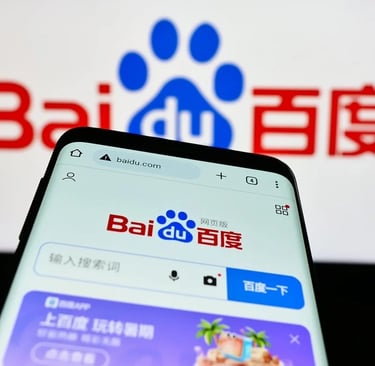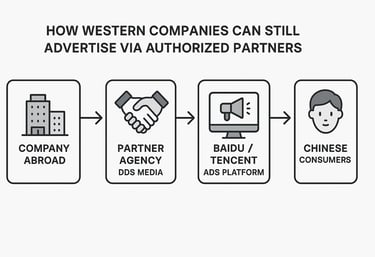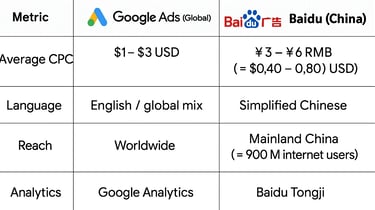Why Google Ads Don’t Work in China (and What to Do Instead)
Learn why Google Ads are blocked inside China, what this means for international brands, and how Baidu, 360 Search, and Tencent Ads can reach real Chinese audiences instead.
Kenneth Ngai
10/28/20254 min read


Why Google Ads Don’t Work in China (and What to Do Instead)
Many Western marketers are surprised when their Google Ads campaigns generate zero impressions from Mainland China. You might even see some traffic from Hong Kong or Singapore and assume the system is working. Then weeks go by and still, nothing from Beijing, Shanghai, or Guangzhou.
Here’s the truth: Google Ads don’t work in China. But that doesn’t mean you can’t advertise there. It just means you have to play by a very different set of rules.
Why Google Ads Don’t Work in Mainland China
1. The Great Firewall blocks Google services
All of Google’s core domains including Google Search, Ads, Analytics, and YouTube are inaccessible behind China’s “Great Firewall.” When a user in Mainland China tries to access google.com, the connection times out. That means no search results, no display network visibility, and no ad delivery.
2. No visibility or targeting for Mainland users
Even if you set your location targeting to “China,” your ads won’t appear to Chinese users because Google’s ad servers can’t reach them. Campaigns may run in Hong Kong, Taiwan, or overseas Chinese communities, but not within Mainland China’s network.
3. Tracking and analytics don’t function properly
Because Analytics and Ads scripts rely on Google’s blocked domains, your tracking pixels won’t fire. This leaves marketers flying blind no impressions, no conversions, and no accurate performance data from Mainland audiences.
4. Market share tells the story
Google holds less than 2 percent of China’s search engine market. Baidu dominates with over 60 percent, followed by 360 Search, Sogou, and Shenma. In other words, even if Google worked, it wouldn’t be where most Chinese users are searching.
Who Can See Google Ads “in China”?
There’s some nuance here. You can reach Chinese-language speakers using Google Ads, just not those physically located in Mainland China.
Your campaigns might appear to:
Chinese speakers abroad (for example, in Singapore or Malaysia)
Mainland visitors browsing from overseas through VPN connections
Expats in Hong Kong or Taiwan
If you’re trying to reach customers inside Mainland China, Google Ads simply isn’t an option.
What to Do Instead
Baidu Ads (百度推广)
Baidu is China’s equivalent to Google, with a nearly identical ad structure: search campaigns, display networks, audience targeting, and remarketing. It’s highly effective for both B2B and B2C advertisers, provided your content and landing pages are localized in Simplified Chinese.
360 Search Ads
360 Search (好搜) caters to tech-savvy and professional users. It offers keyword-based search advertising and lower CPCs than Baidu. It’s a good secondary platform for brands targeting business or IT audiences.
Tencent Ads
Tencent controls WeChat, QQ, and several of China’s largest mobile ecosystems. Its advertising system combines social data with search intent, allowing precise audience targeting—similar to Meta and Google combined.
Other viable platforms
Sogou (搜狗): Language-related search, especially voice and typing input.
Bilibili & Douyin: For video and younger demographics.
Each serves a niche, but Baidu remains the best starting point for search intent.
How to Run Ads in China Without a Local Entity
Traditionally, running ads on Baidu or Tencent required a Chinese business license. That’s changed.
Foreign brands can now advertise through authorized local partners such as international agencies with verified accounts.
A qualified partner handles:
Campaign setup under their verified account
Payment and invoicing in RMB
Landing-page hosting and ICP proxying (to ensure the site loads inside China)
Compliance with ad regulations and keyword policies
This allows Western companies to advertise legally without opening a Chinese subsidiary.




Cost and Performance Comparison: Google vs Baidu
Baidu’s cost per click tends to be lower, but competition and conversion rates vary by sector. The critical factor is localization a direct translation of English ads rarely performs well.
Tracking and Reporting Workarounds
Because Google Analytics is blocked, use Baidu Tongji for web analytics. It integrates with Baidu Ads for conversion tracking and provides detailed data on user behavior inside China.
You can also set up dual tracking: Baidu Tongji for China and Google Analytics for global campaigns. Keep hosting environments separate to avoid latency and data loss.
Checklist: Moving from Google Ads to Baidu or Tencent
Translate and localize your keyword lists.
Build a Simplified Chinese landing page hosted in or near Mainland China.
Partner with an authorized Chinese ad agency.
Adjust CPC expectations (lower but variable).
Implement local analytics and tracking.
Test ad creatives adapted to Chinese cultural norms.
Monitor and optimize continuously.
Conclusion: Stop Waiting for Google Ads in China
Google isn’t coming back to China anytime soon. Waiting for access to return means leaving hundreds of millions of potential customers untapped.
The solution isn’t complicated. It’s localized.
By advertising on Baidu, 360 Search, or Tencent, Western companies can build brand presence and generate leads where their audiences actually are.
DDS Media helps international businesses do exactly that.
If you’re ready to see how your campaigns could perform on Chinese search engines, reach out for a free strategy consultation.
Are you ready to expand your reach ?
Diversified Digital Strategies
Diversifying your paid media for APAC reach.
Choose DDS Media Services reliable & affordable partner for your Asia expansion strategy.
Connect
Grow
(+31) 644010794
© 2025. All rights reserved.
Pages
